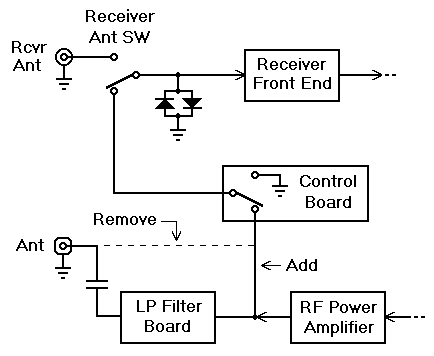
Larry East, W1HUE
Tucson, Arizona
(contact author)
This note appeared in the Idea Exchange column of the July 1996 issue of
the QRP Quarterly.
I fired up my trusty old Argonaut 509 on 20 meters for the first time in several months and heard nothing but noise between 14 MHz and about 14.1 MHz! The noise disappeared when I disconnected the antenna (a 5-band trapped vertical), but the same antenna connected to my FT-301 produced NO excessive noise. Other bands on the 509 were OK - just the low end of 20m was noisy. So, I set about looking for bad solder connections, etc. in the 509 front end; I even removed the input protection diodes and performed a complete realignment. No change in the noise! Figuring that maybe the problem was caused by a local AM broadcast station (the noise did sound a bit like splatter), I installed a crude filter to attenuate signals below about 2.5 MHz at the receiver input. The noise was still there! I did some more looking around in the rig, but could not find anything amiss. Then I just happened to connect a low-pass filter between the rig and antenna, and presto! The noise was gone!
As near as I can tell, the problem is caused by a new high power FM broadcast transmitter located on a hill about 4 miles from me. Why it only effects the low end of 20m, I don't know. I have since had reports from other Argonaut 505/509 owners that they too have been bothered by high power VHF TV/FM stations. Its possible he 515 model does not have the problem since it does not use a dual-gate MOSFET mixer as do the earlier models.
My solution to the problem was to do some minor rewiring to use the transmitter output filter as a low-pass filter for the receiver input. Normally the receiver input is connected directly to the antenna connector. Although a 9 MHz filter and "peaking" circuit are located at the receiver's RF amplifier input, strong VHF signals apparently still get into the RF amplifier and/or mixer.
The change is easy to make in the 509; simply remove the wire going from the output antenna connector to the control board connector and replace it with a piece of RG-174 from the control board connector to the end of the low pass filter connected to the final amplifier (NOT the antenna end!). The RG-174 can be snaked under the IF board, then behind the final amplifier board and connected to the final amplifier board connector; be sure to ground the shield at both ends. The resulting circuit will (or should!) be as shown in the figure:

Making the change in an Argonaut 505 is a little more complex since the relay on the control board actually switches the antenna connector between the LP filter output and the receiver input, rather than just grounding the receiver input on transmit. The best approach would probably be to use the arrangement shown in the figure; that is, rewire the relay to ground the receiver input during transmit. I am not too familiar with the physical layout of the 505, but I don't believe that this should be too difficult.
If you run into VHF interference problems in your Argonaut and don't want
to make any internal changes to the rig, you can always use an external
low pass filter.
————
Copyright © 2005, 2012 by Larry East, W1HUE ————

Page last updated on June 18, 2012